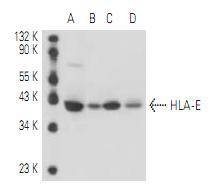Major histocompatibility complex (MHC) molecules, which include human leukocyte antigens (HLAs), form an integral part of the immune response system. They are cell surface receptors that bind foreign peptides and present them to cytotoxic T lymphocytes (CTLs). MHC class I molecules consist of two polypeptide chains, an α or heavy chain and a non-covalently associated pro- tein, β-2-Microglobulin. The differential structural properties of MHC class I and class II molecules account for their respective roles in activating different populations of T lymphocytes. HLA-A is a MHC class I heavy chain molecule that plays a central role in the immune system by presenting peptides derived from the endoplasmic reticulum lumen. HLA-B and HLA-C are proteins encod- ed by closely related genes that also exist in the MHC class I. HLA-E belongs to the HLA class I heavy chain paralog. HLA-E is a heterodimer consisting of a heavy chain and a light chain; the heavy chain is anchored in the membrane. HLA-E binds a restricted subset of peptides derived from the leader peptides of other class I molecules.

